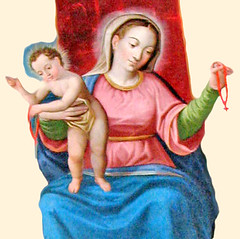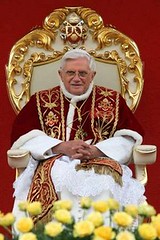St Felix and Norwich
 I jokingly told Br Paul yesterday that today was the feast of the patron saint of cats - St Felix. He was less than impressed with the idea but I think he is resigned to the fact that most of the Dominicans at Blackfriars Cambridge either talk to Leo (the priory cat) or about Leo! However, I wasn't altogether wrong: according to the Wikipedia, there is a Cornish Saint Felix who "was said to have had the miraculous gift of being able to communicate with lions, cats, and other feline creatures"!
I jokingly told Br Paul yesterday that today was the feast of the patron saint of cats - St Felix. He was less than impressed with the idea but I think he is resigned to the fact that most of the Dominicans at Blackfriars Cambridge either talk to Leo (the priory cat) or about Leo! However, I wasn't altogether wrong: according to the Wikipedia, there is a Cornish Saint Felix who "was said to have had the miraculous gift of being able to communicate with lions, cats, and other feline creatures"!
But that is not the St Felix whose memory the diocese of East Anglia rejoices in today. Today's feast honours St Felix of Burgundy who was the apostle to the people of East Anglia in the 7th century (shown on right in a stone relief from Norwich cathedral). He converted King Sigebert of the East Angles to Christianity c.630 and reputedly also converted Etheldreda, saint and princess whose shrine was at Ely cathedral. As such, today we celebrate the missionary and bishop who first brought Christianity to this area of Britain where our priory lies. The seat of St Felix's diocese was at Dunwich on the Suffolk coast which was once a prosperous town of 4000 inhabitants. However over the centuries it has been ravished by great storms and coastal erosion, until today most of Dunwich has been claimed by the sea!
As such, the diocese he began is now based in Norwich where the Catholic bishop of East Anglia has his cathedra and also where the more ancient cathedral of Norwich is. Br Paul and I had the oportunity to visit this beautiful city, which was once the second most prosperous and important city in England, last month. Following are a few photos of Norwich and its historic sites:

 These photos here show the exterior of Norwich cathedral, as seen from the cloister and the interior of the cathedral showing the chancel and the bishop's throne in its apsidal position. The cathedral was begun in 1096 and was initially a Benedictine monastery, hence its large and beautiful cloister which has an interesting array of roof bosses. Our lay Dominican friends, Danny and Debbie Otero, have good photos of these and of Norwich on their blog.
These photos here show the exterior of Norwich cathedral, as seen from the cloister and the interior of the cathedral showing the chancel and the bishop's throne in its apsidal position. The cathedral was begun in 1096 and was initially a Benedictine monastery, hence its large and beautiful cloister which has an interesting array of roof bosses. Our lay Dominican friends, Danny and Debbie Otero, have good photos of these and of Norwich on their blog.
In the photo above, I am standing in the cloister of Norwich cathedral. This is the only two-storey cloister in England and one of the largest in the country. As we have seen in previous posts, double-tiered cloisters are much more common in Spain.

Norwich is also home to the last (and only) surviving medieval Blackfriars in England. Above is a photo of Br Paul and I outside the church which is now Blackfriars Hall, a multi-purpose hall owned by the city council and used for concerts, exhibitions and functions. The Dominican friars arrived in Norwich in 1226 and built this priory in the 14th century and lived, preached and prayed on this site until they were ousted in the Protestant Reformation.
 We walked around with awe and a sense of sadness as we looked at what remained of the medieval Dominican presence in England. A kind gentleman who was on duty was very excited to see two Blackfriars return to Blackfriars Norwich and he specially let us into the crypt to view the oldest parts of the priory. We also walked around what remained of the cloisters, we sang the O Lumen in what was once the priory church (left) and stood amidst the ruins of the priory and cloister, each lost in thought and prayer. Do click here to view a panoramic photo of the cloister remains.
We walked around with awe and a sense of sadness as we looked at what remained of the medieval Dominican presence in England. A kind gentleman who was on duty was very excited to see two Blackfriars return to Blackfriars Norwich and he specially let us into the crypt to view the oldest parts of the priory. We also walked around what remained of the cloisters, we sang the O Lumen in what was once the priory church (left) and stood amidst the ruins of the priory and cloister, each lost in thought and prayer. Do click here to view a panoramic photo of the cloister remains.Below is a sepia-tinted photo of Br Paul in the ruins of the priory with the arches of what is left of the priory in the background. On the day we visited, it was filled with stalls for a craft and second-hand fair... The church which once rang with chant and preaching stood empty, devoid of life and the vibrancy of the faith that gave it birth. After a while, it was just too sad to be there and to contemplate what was now a vestigial shell of Catholic England and the faded presence of our ancestors-in-the-Order in Norwich! But we are grateful that at least this one priory building and church was to survive largely intact and that it is being well maintained by Norwich City Council.

We decided to visit the church of the famous English mystic, Julian of Norwich whose anchorite cell still survives, attached to the little parish church of St Julian (below). There was a sense of peace in Mother Julian's cell and prayer pervaded the place where she lived, received her mystical revelations and wrote her books. Incidentally, Julian of Norwich had a cat and no doubt spent many a happy hour with it in her cell! Again, for more photos of this church and Julian's cell and of Norwich, do go to the Otero's blog.

Norwich also has a rather cuboid Norman castle (below right).
 Looking at it, Br Paul and I were struck by its stark simplicity and also how it could very well have been built in the 1960s when most buildings were block-shaped! The castle now houses a museum but we had not the time to enter.
Looking at it, Br Paul and I were struck by its stark simplicity and also how it could very well have been built in the 1960s when most buildings were block-shaped! The castle now houses a museum but we had not the time to enter.We had to make our way to the Catholic Cathedral of East Anglia, which stood across the city from the Anglican cathedral, for the reason for our day in Norwich was to attend the diocesan Chrism Mass!
The Catholic cathedral (the interior, shown below) was built in the 19th century in an early English Gothic style and is a beautiful example of the revival of the Catholic faith in England in that period. Dedicated to St John the Baptist, its tower can be seen across the city, proudly proclaiming the faith as once its patron did.

It was wonderful to celebrate the Chrism Mass with people from all over this diocese and to meet and chat with some of them afterwards. As young religious men at this event, visibly present in our habits, we attracted quite a few people who wanted to know where we were from! That was a good way to break the ice and for us to meet people... There were about 1500 people at that Chrism Mass and their presence around the bishop, Michael Evans, a successor of St Felix, signified to us the continuing vibrancy of the faith of St Felix in Norwich and its environs.
Therefore, let us give thanks to God for the seed of faith sown by St Felix in East Anglia. Let us pray for Bishop Michael, for his clergy, the religious and laity of the diocese of East Anglia and implore the intercession of Mary Immaculate, of St John the Baptist and St Felix of Burgundy. May God prosper the diocese and invigorate the Faith among His people, leading us to witness to His love and grace among the people of Norwich and East Anglia.







1 Comments:
Thanks for the plug, Lawrence. We did not venture into Blackfriars at Norwich (but I did contemplate trying). Knowing that it had probably undergone extensive renovations, I decided not to try. But your photos seem to indicate that less was altered than I would have expected.
Post a Comment
<< Home